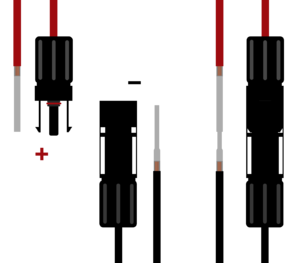Difference between revisions of "Module connectors"
| (6 intermediate revisions by the same user not shown) | |||
| Line 1: | Line 1: | ||
| − | [[File:Mc4connector.png|thumb| | + | [[Category:PV source]] |
| − | [[PV module|PV modules]] are installed outdoor and exposed to the elements, therefore any connections made with PV modules should be water-tight. PV modules are typically connected to one another, or to a wire that goes to a combiner box, with specialty connectors designed for | + | <languages /> |
| + | <translate> | ||
| + | <!--T:1--> | ||
| + | [[File:Mc4connector.png|thumb|Positive, negative and joined MC4 connectors depicted with wiring.]] | ||
| + | |||
| + | <!--T:2--> | ||
| + | [[Special:MyLanguage/PV module|PV modules]] are installed outdoor and exposed to the elements, therefore any connections made with PV modules should be water-tight. PV modules are typically connected to one another, or to a wire that goes to a combiner box, with specialty connectors designed for use with PV modules exposed to water and sun. These connectors are designed to be crimped onto wires using a specialty crimper. They can then be easily snapped together, but typically require a tool to separate them once connector to avoid accidents. | ||
| + | |||
| + | <!--T:3--> | ||
| + | Modules can come with different types of connectors - MC4 (the most common type of connector which is produced by Staubli), Amphenol, Tyco - which are not compatible with one another. So it is important to make sure that you have the correct type of connector to be able to make a connection with the PV module. Otherwise a high resistance connection can be created that might lead to a failure or a fire. It is also important that a crimping tool designed for use with the specific type of connector is used. | ||
| + | |||
| + | ==Notes/references== <!--T:4--> | ||
| + | |||
| + | </translate> | ||
Latest revision as of 14:15, 10 February 2021
PV modules are installed outdoor and exposed to the elements, therefore any connections made with PV modules should be water-tight. PV modules are typically connected to one another, or to a wire that goes to a combiner box, with specialty connectors designed for use with PV modules exposed to water and sun. These connectors are designed to be crimped onto wires using a specialty crimper. They can then be easily snapped together, but typically require a tool to separate them once connector to avoid accidents.
Modules can come with different types of connectors - MC4 (the most common type of connector which is produced by Staubli), Amphenol, Tyco - which are not compatible with one another. So it is important to make sure that you have the correct type of connector to be able to make a connection with the PV module. Otherwise a high resistance connection can be created that might lead to a failure or a fire. It is also important that a crimping tool designed for use with the specific type of connector is used.
